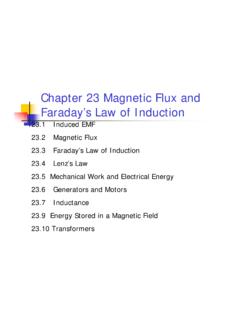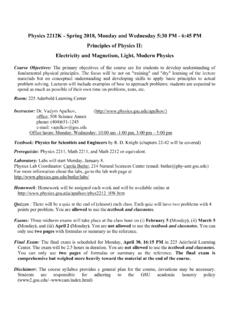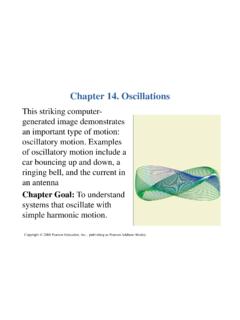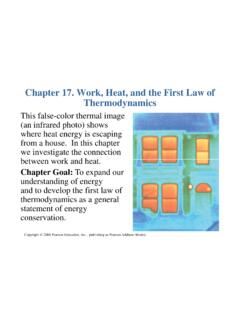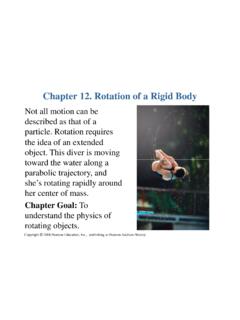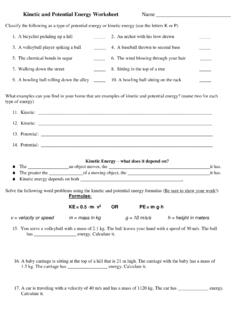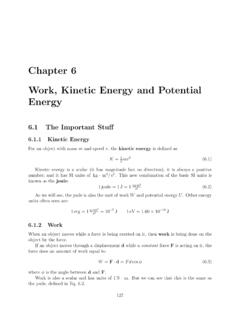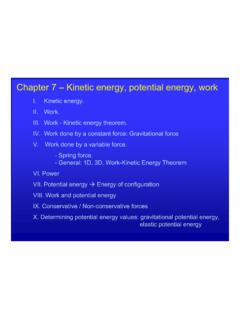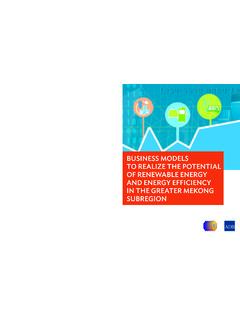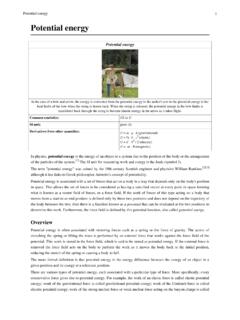Transcription of Electric Potential Energy Chapter 20 Electric Potential and
1 Chapter 20 Electric Potential and Electric Potential Electric Potential Energy and the Electric Energy The Electric Potential of Point Equipotential Surfaces and the Electric Capacitors and Electrical Energy StorageEnergy conservation: Very important in mechanics. Also very useful in electrostaticsObjects in gravitational fields have Potential Energy (PE).Similarly, Charges in Electric fields have Electric Potential Energy (U)To move an object in a gravitational field requires work. There is a change in the object s , To move a charge in an Electric field requires work.
2 There is a change in the charge s gravitational fields a force is required to move masses apart. That is, positive work is done (by an external agent-you). Similarly, In Electric fields a force is required to push like charges is positive work is done (by an external agent-you). Electric Potential and Electric Potential Energy (EPE) Electric Potential and Electric Potential Energy (EPE)+++++++++Force Not from field given to chargeForceRequiredForce required to push charges together. That is, positive work needs to be done (by you).
3 When charges pushed together there is an increase charges released they will accelerate apart and the EPE is turned into thing in gravitational 20 1 Change in Electric Potential energya) A positive test charge q0experiences a downward force due to the Electric field E. If the charge is moved upward a distance d the work done by the Electric field is -(q0)Ed. At the same time, the Electric Potential Energy of the system increases by (q0)Ed. The situation is analogous to that of an object in a gravitational field.
4 (b) If a ball is lifted against the force exerted by gravity, the gravitational Potential Energy of the system in Electric Potential energyEPE IncreasesPE IncreasesIn the above: You do positive work, the field does negative things happen spontaneously: The field does positive work YOU do negative workElectric field uniform U = UB-UA= -W = q0Ed Change in Electric Potential Energy of a charge on moving from A to BWork Done by an Electric Force, W=-qoEdWork Done by an YOU, -W=qoEdGravitational field uniformChange in Electric Potential V = VB-VA= U/ q0= -W / q0 Potential differencebetween points A to BMeasured in Volts1 Volt = 1 J/CWork Done By an Electric FORCEIt s important to know who does the work!
5 For a uniform field between two plates V = U / q0= q0Ed / q0= Ed or E =- V / sPotential difference depends only on the plates and NOT on any charge being work done depends on the size of the charge being Potential difference more important than the actual value of Electric potentialThe change in Potential Energy or the work done depends on the size of the charge being 20 2 Electric field and Electric potentialAs a charge q0moves in the direction of the Electric field, E, the Electric Potential , V, decreases.
6 In particular, if the charge moves a distance <s, the Electric Potential decreases by the amount <V = -E < is Electric field related to Electric Potential ?Use Dimensional or unit analysisElectric field is measured in units of N/CdVE)()(22===== SomVmCJCNJ mkgmsCkgmsCNF=maWD=FdFigure 20 3 The Electric Potential for a constant Electric fieldThe Electric Potential , V, decreases as one moves in the direction of the Electric field. In the case shown here, the Electric field is constant; as a result, the Electric Potential decreases uniformly with distance.
7 We have arbitrarily set the Potential equal to zero at the right-hand 10:A pair of parallel plates is charged by a 24 V battery. How much work is required to move a charge of 4 C from the positive to the negative plate?++++++------24 VNOTICE: Which plate is at higher Potential and WHY?-Youwill have to do positive work to move the charge as directed. V = VB-VA= -24 V = UE/ q0= W / q0(-24 V) q0= W = + VBis less than VA. BUT the charge is negative and the work done (by you)is positiveABA proton has a charge of proton gains kinetic Energy equal to the Potential Energy Energy lost = qV= (10,000 V)( )= (3 marks)KE = mv2= (1 mark)A proton has a mass of ( ) / ( ) = = (3 marks)Note: Take care to distinguish between velocity, v and voltage VProblem 13:A proton is accelerated by a Potential difference of 10 kV.
8 How fast is the proton moving if it started from rest (7 marks)?Problem 11: A uniform Electric field of 1200 N/C points to the left as shown. A What is the difference in Potential (VB-VA) between points B and A? B What is the difference in Potential (VB-VC) between points B and C? C What is the difference in Potential (VC-VA) between points C and A?D Is it possible to determine the value of the Electric Potential at point A? If not, explain why. BAB ABCCA11. V=V -V = 0 because V =VN V=V -V = -Ed=-(1200)( m)=-48 VCN V=V -V = Ed=(1200)( m)=+48 VCabc Problem 11 Problem 14 The Electric Potential along the x-axis is shown.
9 Find the Electric field at positions 20 4 Energy conservation in an electrical system A test charge, +q0, is released from rest at point A. When it reaches point B its kinetic Energy will have increased by the same amount that its Electric Potential Energy has Electric Potential of a point charge(need calculus to prove this)At rA= infinity, the Potential is defined to be ZERO charge QrkQV=== or r kQ V VBB r kQ-r kQ V-V V ABAB== Equation is validONLY for a point chargeMutual Electric Potential Energy of point chargesIf we move a positive charge from a very great distance to a distance r12from another charge, there is an increase in Potential Energy because positive work must be done to bring the mutually repelling charges closer active example more than two charges.
10 The system's Electric Potential Energy is the sum of the energies of each 20 6 Equipotentials for a point chargeEquipotentialsurfaces for a positive point charge located at the origin. Near the origin, where theequipotentials are closely spaced, the Potential varies rapidly with distance and the Electric field is large. Figure 20 7 Equipotential surfaces for a uniform Electric fieldElectric field lines are perpendicular to the equipotential. surfaces. Electric field lines point in the direction of decreasing 20 9 Electric charges on the surface of ideal conductorsa) On a spherical conductor the charge is distributed uniformly over the surface.
